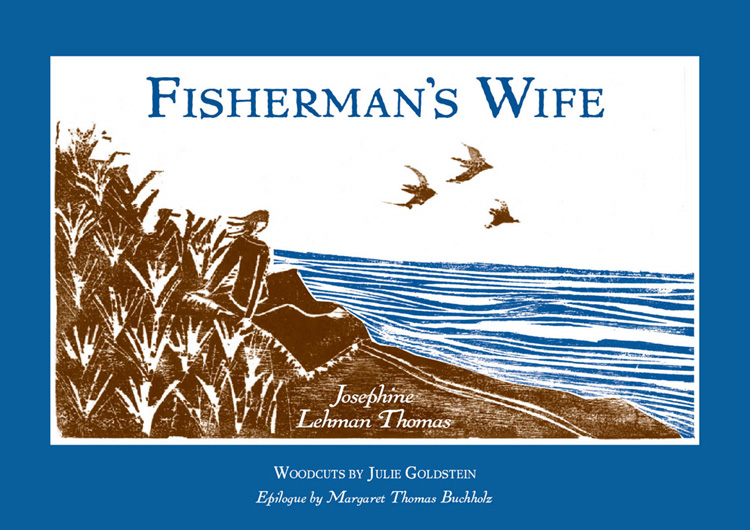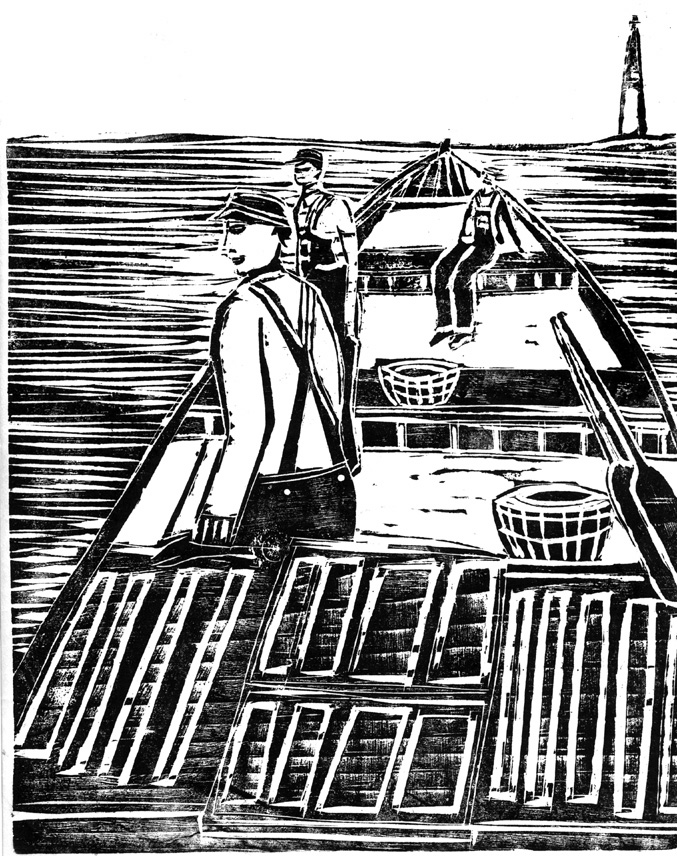can sympathize with the young couple
struggling to survive the Depression.”
— The Press of Atlantic City
an emotional touch to this profound story;
highly recommended.”
— Wisconsin Bookwatch

|
Fisherman's Wife
By Josephine Lehman Thomas |
||||
|
A tender love story of the early 1930s…touching, elegantly illustrated.”
— The SandPaper |
||||
|
ABOUT THE AUTHOR |
||
IN THIS POIGNANT STORY, the failing economy of 1931 forces a successful young couple to give up their cosmopolitan New York City lifestyle for a simple life at the edge of the sea. For Jo, the “fisherman’s wife,” the relocation turns out to be more than she bargained for. She had been a globe-trotting writer and researcher for one of the legendary reporters of the 20th century. Soon pregnant, she and her husband struggle to make a home and live frugally. He tries to meet expenses as a commercial fisherman, while she is alone in their house on a winter beach, enduring the nausea of pregnancy and worrying about her spouse at sea. She misses the encounters with power and wealth her career brought her, the comforts and security of their lives before storms and struggle became the norm.
Yet, they find true happiness. First published during the Great Depression, this timeless story reveals how sacrifice, hardship and trust can create a common bond of love; how there is a deep sense of fulfillment in working together and discovering that, as the author writes “...something much finer was welded between us than we found in the first prosperous days of our marriage.”
Beautifully illustrated with traditional woodcuts by contemporary printmaker Julie Goldstein, the story includes an epilogue by New Jersey shore history author Margaret Thomas Buchholz.

EXCERPTS
Copyright © Margaret Thoms Buchholz. Illustrations © Julie Goldstein. All rights reserved.
The wind off the Atlantic is raw at four o’clock in the morning, even in summer, and I pull my sweater closer about my throat as Tom and I walk down the sandy road between the tarpaper shacks where the fishermen live. The long, low fish shed on the dock and the high round shaft of Barnegat Lighthouse are beginning to take form out of the darkness. The slightly sour smell of Barnegat Bay salt marshes is strong in the air.
The waves lap softly against the fishing skiffs tied in orderly rows along the breakwater. The fishermen, awkward in rubber hip-boots and stiff yellow oilskins, shuffle clumsily past the piles of wooden boxes and wire baskets to stow their gear and tin lunch cans in their boats.
They make their preparations swiftly and with little to say beyond an occasional speculative comment about the weather.
“What you think about it, Axel?” The names one hears are like that — Axel and Olaf, Sven and Hans. Except for Tom and two or three native Barnegaters, these men of the fishing fleet are Scandinavians with the blood of seafaring Norsemen in their veins.
Axel scans the sky, the stars overhead, the faint pinkish glow on the eastern horizon. “Looks all right to me.”
The other is getting the feel of the wind. “I don’t think she shift before night.”
Tom climbs down into his skiff and does something with a monkey wrench. There is a staccato sputter, and the motor starts with a roar. As it warms up, he pulls on oilskins and boots, and listens to the speculation about the weather. Axel, the acknowledged weather prophet, takes another long look at the sky.
“I think she is a good day. I shove off,” he announces.
When one man starts the others follow. Tom kisses me good-bye, and Olaf Svenson in the next boat looks embarrassed and nudges his partner. These Scandinavians would rather lose a day’s catch of fish than be seen in a public gesture of affection toward their wives.
Lines are cast off, motors throttled down, and one by one the huge gray sea-skiffs slip out of the dock basin. Tom’s boat leaves a scimitar of foam in its wake as it rounds a bend in the channel and disappears behind the low sand dunes, and I have my last glimpse of him as he stands at the tiller, fastening his oilskins more securely. It will be wet going through the narrow inlet where the tide is running swiftly out of Barnegat Bay and meeting the big rollers of the Atlantic.
The last boat is lost in the early morning grayness, and inside me is the dull emptiness I feel every time Tom puts to sea. I walk back down the road to where the flivver is parked, beside the little lunch room where two fish-truck drivers are going in for early morning coffee and fried potatoes. They glance at me curiously as I hurry along, and one asks the other a question. The answer comes to me clearly in the still morning air:
“Her? Oh, just one of the fishermen’s wives.”

READER COMMENTS
This poignant story takes place at the Shore during the Great Depression, and it garnered these adoring reviews when it was included in the anthology Shore Stories in 1997 —
“Fisherman’s Wife has resurfaced again as one of the most captivating pieces of prose… captures many of the hardships and uncertainties faced by those who lived off the sea on that ‘barren island’ in those days. But its value as historical documentary is overshadowed by what is, in essence, a love story.” —Asbury Park Press
“First published by Scribner’s in 1933, the story tells in careful, succinct and powerful prose what life was like for a couple of former Lost Generation ‘swells’ who found themselves suddenly broke, pregnant and literally bottomed-out on Barnegat Bay at the very bottom of the Depression.” —Star-Ledger
“…Rich with details of island life… The story is told with unsparing honesty by [Jo], formerly a well-paid journalist in New York who had traveled the world. Now, as a fisherman’s wife — pregnant, living in a tiny cottage, cooking on a ‘smoky oil stove’ — she worries whenever her husband is late coming home, fearing that he has drowned. As they face the threats of poverty, storms and isolation, however, the two make sacrifices and draw closer together in a way that would not have been possible in their former lifestyle.”
—The Beachcomber
JOSEPHINE LEHMAN THOMAS (1898-1959) was born on a farm in Ionia, Michigan, one of ten children. She became a reporter for the Ionia Sentinal, and in 1918, answering a call for war workers, moved to Washington DC and became a clerk at the War Department. After World War I she worked for author Frank Carpenter, and then in 1924 moved to New York and worked as an editor and ghost writer for Lowell Thomas.
JULIE GOLDSTEIN is a fine art printmaker who draws inspiration from the natural environment, the sea, and surf culture. In multimedia works on paper and fabric, she mixes lithographic and woodcut printmaking techniques with sewing, embroidery, and other traditional “women’s arts” — the result is a hybrid, contemporary style with urban motifs. She has exhibited on the west and east coasts since 1998, including solo shows from Raleigh, NC, to Portland, ME, and in international group shows in France, Japan, and Brazil. Her work has appeared in Surfer Girl Magazine, the website dailycandy.com, and has received honors from the Long Beach Island Foundation for the Arts and the Printmaking Council of New Jersey. She received an MA at Columbia University and a BFA in 1997 from the University of Connecticut, and lives and works on Long Beach Island, NJ.
MARGARET THOMAS BUCHHOLZ is co-author of Great Storms of the Jersey Shore, New Jersey Shipwrecks: 350 Years in the Graveyard of the Atlantic, and editor of Shore Chronicles: Diaries and Travelers’ Tales from the Jersey Shore 1764-1955. Her essays about the New Jersey Shore have also been included in anthologies and collections. Buchholz was publisher of the Long Beach Island, New Jersey Shore, newspaper The Beachcomber from 1955 to 1987, and is still an editor. She grew up in Harvey Cedars, where her family has been coming since 1833, and currently lives year-round in her childhood home on the Island.


e-mail downshore@gmail.com • (609) 812-5076 fax (609) 812-5098
Copyright © 2019 Down The Shore Publishing Corp. The words "Down The Shore" and logo are a registered U.S. Trademark.